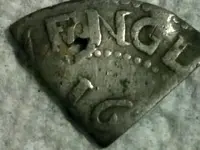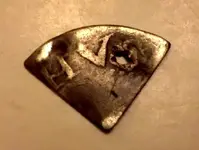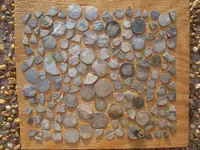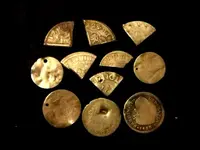When copper coins or smaller denomination silver wasn't available, coins were cut to make change for small purchases. The practice was common in Europe in the days of hammered silver coinage. The most commonly cut coins in the US are the Spanish Milled Reales. The cross on those coins made cutting much more convenient. The cut pieces were known as "bits", sharp silver and frontier change. Finding cut pieces usually means that significant trade was conducted in the area and the chance of finding more coins is strong. An Oak or Pine Tree Shilling had a value of 12 pence, which would mean that the bits we have found were worth 2-3 pence apiece depending on how much they weighed.

 Hello folks. I found this cut piece a few years ago and had it placed with some other cut Spanish coins until recently I noticed it was different. I now know it is a 1652 Oak Tree Shilling. My quest is to find out more about it. What variety may it be? Should I get it authenticated? A fellow on another Forum(oxbowbarefoot) gave me some great insight on my piece. He stated it could possibly be a Noe 13.6 or 13.9 or even a 14. Upon this, looking at mine and seeing what those look like, it does seem to appear a match to the 13.6. Any thoughts?
Hello folks. I found this cut piece a few years ago and had it placed with some other cut Spanish coins until recently I noticed it was different. I now know it is a 1652 Oak Tree Shilling. My quest is to find out more about it. What variety may it be? Should I get it authenticated? A fellow on another Forum(oxbowbarefoot) gave me some great insight on my piece. He stated it could possibly be a Noe 13.6 or 13.9 or even a 14. Upon this, looking at mine and seeing what those look like, it does seem to appear a match to the 13.6. Any thoughts?





